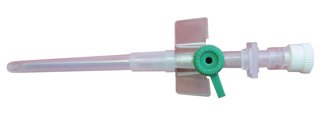IV CATHETER, injection port, s.u. 26 G (0.6 x 19 mm) violet
Valid Article
IV CATHETER, injection port, 26 G
The IV catheters for all other sizes (14G – 24G) have been replaced by safety IV catheters : retractable (SINSIVCSR+++) ones for high risk contexts such as haemorrhagic fever and tip shielded ones (SINSIVCST+++) for all other contexts.
Definition
A sterile, thin, flexible tube intended to be inserted into the peripheral vasculature of a patient to enable short-term (< 30 days) intravascular access. It is not intended to be advanced to the central vasculature. It includes dedicated accessories to facilitate catheter introduction/placement and function: injection port, stylet and wings for fixation. It may be used to administer fluids or medication.
Specifications
Quality standards
- EN ISO 10555-1, 2013, edition 3, +A1 2017 Sterile, single-use intravascular catheters - Part 1: General requirements
- ISO 10555-5, 2013, edition 2, (confirmed 2018) Sterile, single-use intravascular catheters - Part 5: Over-needle peripheral catheter
Technical specifications
- CATHETER
- polyurethane (PUR) or FEP
- straight and tapered distal end
- translucent hub with standardized colour code (ISO 10555-5) and female Luer connector
- fitted with wings (Butterfly)
- fitted with an injection port
- STYLET
- stainless steel
- slightly longer than the cannula
- bevelled end
- translucent hub to observe blood reflux
- fitted with a stopper
- PROTECTIVE SHEATH
- Sterile, for single use
Colour code | Gauge | External Ø (mm) | Internal Ø (mm) | Catheter length (mm) | Flow rate (ml/min) |
violet | 26 | 0.64 | 0.45 | 19 | 19 |
Caution, the colour code used to denote Gauge is different from that used for other needles.
Packaging & Labelling
Unit sterile packaging in peel-open pack
Instructions for use
Please consult the Manual of nursing Care Procedures, MSF, 2020 available online via the Nursing care working Group sharepoint page.
Precautions for Use
Ensure that the baby is warm when placing an IV line: if the baby is cold, the risk of vein rupture during the canalization is higher.
Be carefull with the use of a tourniquet: not too long and not too tight as this may also increase the risk of vein rupture. Option: ask the assistance of another colleague that uses her/his hand as tourniquet, so the pressure applied is much more controlled.





![[DEXTCHLHA2W] CHLORHEXIDINE 2%, 70% isopropyl alcohol, SWAB/WIPE](/web/image/product.template/570781/image_256/%5BDEXTCHLHA2W%5D%20CHLORHEXIDINE%202%25%2C%2070%25%20isopropyl%20alcohol%2C%20SWAB-WIPE?unique=338db47)
![[SINSSTOP2--] STOPPER, Luer-lock male/female, sterile, s.u.](/web/image/product.template/568823/image_256/%5BSINSSTOP2--%5D%20STOPPER%2C%20Luer-lock%20male-female%2C%20sterile%2C%20s.u.?unique=56d156f)